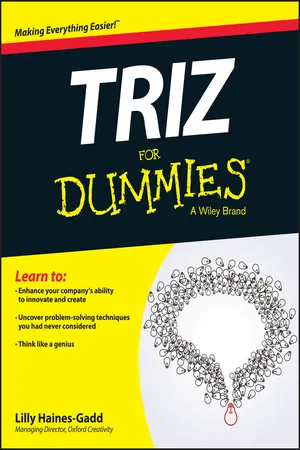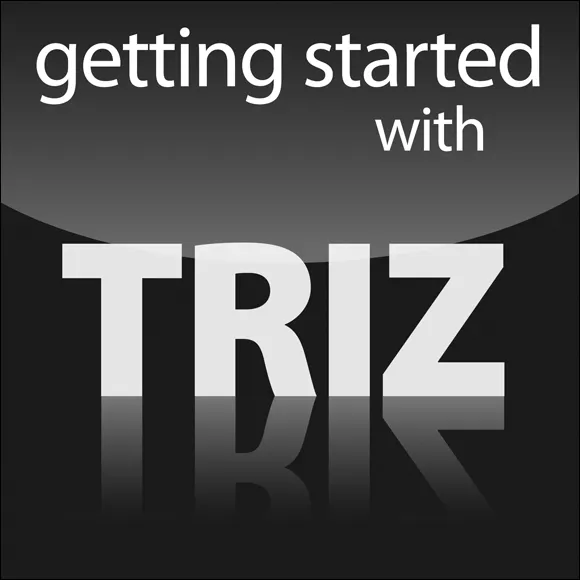TRIZ subdues complexity and keeps detail in its place. TRIZ logic demands that you have a clear idea of where you are and where you’re going, which helps you keep your eye on the prize and avoid getting tripped up with irrelevant detail, waylaid by trivial issues or seduced by premature solutions.
Increasing Ideality
The main goal of TRIZ is to increase Ideality. Ideality is the TRIZ equation for working out how good something is, as shown in Figure 1-1.
The Ideality of a system is the ratio of its benefits compared to its costs and harms:
- Benefits are all the outputs that you want, expressed as outcomes (not solutions).
- Costs are all the inputs required to create a system (not just money but also time, materials, cleverness and so on).
- Harms are all the outputs from your system that you don’t want (even neutral things that aren’t actively harmful).
A system in TRIZ is a very general term: it means any kind of product or process that’s created and used to meet a need.
Ideality is important because it’s very simple, and very brutal. It holds in the front of your mind the reason you’re doing whatever it is you’re doing. The benefits are the outcomes that you want but no mention is made of how you get those benefits. That’s deliberate because it keeps your focus on the outcomes you want and not on exactly how you’ll achieve them. This approach stops you becoming enraptured with solutions too soon, and always reminds you that other ways of getting what you want may exist. When you think about benefits, you consider all the things you want and not merely the outcomes you believe are achievable. This drives you continually to find new benefits you can deliver, and ways to increase the levels of benefits you’re currently achieving.
You’re also aware of all the downsides associated with the various ways of getting what you want. This is important because it forces you to look for problems, which means in turn that you’ll be able to solve the problems and improve your system continually, in an iterative way.
Ideality identifies two kinds of problems:
- Costs (all inputs)
- Harms (all outputs you don’t want)
TRIZ is always looking for ways to reduce costs; not just money but also time, parts, materials, effort – any kind of input required to create your system, in fact. TRIZ thinking pushes you towards creating simple, elegant systems and solutions to problems, which often involves finding innovative ways of getting what you want. While many traditional approaches also consider both costs and benefits (or sometimes functions), thinking about harms provides additional power.
Harms are all outputs you don’t want – they needn’t be actively harmful but are things produced by your system that aren’t useful to you. Examples include things that may seem ‘neutral’ initially, such as heat from a laptop or noise from a washing machine, any complicated features you don’t use on a smartphone, and waste or even potential risk. Thinking about harms encourages a more holistic view of your system, in which you consider its impact in the bigger picture. It also drives you towards simpler, more efficient systems, because all harms are things you’re fundamentally paying for in some way: heat from a lightbulb may not be actively harmful but it is wasted energy, and finding a way to reduce that heat output will result in either more light (increased benefit) or reduced energy use (reduced cost).
All TRIZ tools exist to improve Ideality. They increase benefits, reduce costs or reduce harms – or all three! Ideality is referred to throughout this book because, while you can use it as a standalone tool (see Chapters 5 and 9 for details), it’s also more of a fundamental way of understanding TRIZ and its purpose.
Ideality expresses in a nutshell the duality of TRIZ. On the one hand, you have one eye on utopia and all the benefits you want (even though you know you probably won’t get them). On the other hand, you’re searching for all the problems that exist in your real-world system (so you can get rid of them). TRIZ helps you connect fantasy and reality: you allow yourself to imagine perfection and engage with the nitty-gritty of practical systems. Obviously, this behaviour is a contradiction; however, TRIZ says the world is full of contradictions and you shouldn’t be afraid of them, ignore them in the hope that they’ll go away or compromise too soon in an attempt to resolve them. Ideality is a concept that balances the good and bad in any kind of system, and holds them together at the same time. Understanding and appreciating the conflict between the good and the bad allows you to work in an ambiguous, creative and potentially very fruitful space.
Uncovering patterns in human creativity
The logic underpinning TRIZ is that patterns exist across problems and the solutions that have previously been found to those problems. If you can understand how your situation is similar to previous situations, you can short-circuit the problem-solving process and generate very creative solutions.
TRIZ was observed, not invented. The earliest research found that the same problems occur again and again across different industries, and that very similar solutions are found to these problems (Chapter 2 gives you the lowdown on how TRIZ was developed).
For any problem you encounter, chances are that someone else will have seen something similar in the past – and found a solution. Even more excitingly, the solutions people come up with also exhibit similarities. What the TRIZ community has captured are the patterns that exist in both the kinds of problems that people address and the way in which they solve them. These patterns have been encapsulated in a series of thinking tools that the rest of us can apply to solve our problems.









